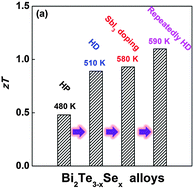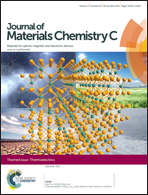High performance n-type bismuth telluride based alloys for mid-temperature power generation†
Abstract
Currently more than 60% of primary energy used in industry or life is lost as waste heat in the temperature range of 400–900 K, and much attention is paid to mid-temperature thermoelectric (TE) power generation. Here we combine several strategies, i.e. alloying, doping and hot deformation, to improve the TE performance of n-type bismuth telluride based TE alloys for mid-temperature power generation. Se alloying was adopted to widen the band gap and suppress intrinsic conduction at elevated temperatures. When Se atoms completely substitute the Te(2) atoms, the crystal structure of Bi2Te3 based alloys tends to be more ordered, resulting in the maximum value of the band gap. And the induced alloying scattering significantly reduces the lattice thermal conductivity. Then SbI3 donor doping was used to increase the electron concentration to further suppress the detrimental effects of bipolar conduction. Finally we applied repetitive hot deformations to further improve the figure of merit zT and a peak zT of ∼1.1 was obtained at about 600 K in the 0.1 at% SbI3–Bi2Te1.9Se1.1 alloy, which was hot-deformed three times. The results demonstrated the great potential of the alloy for application in mid-temperature TE power generation.

- This article is part of the themed collection: The Chemistry of Thermoelectric Materials

 Please wait while we load your content...
Please wait while we load your content...